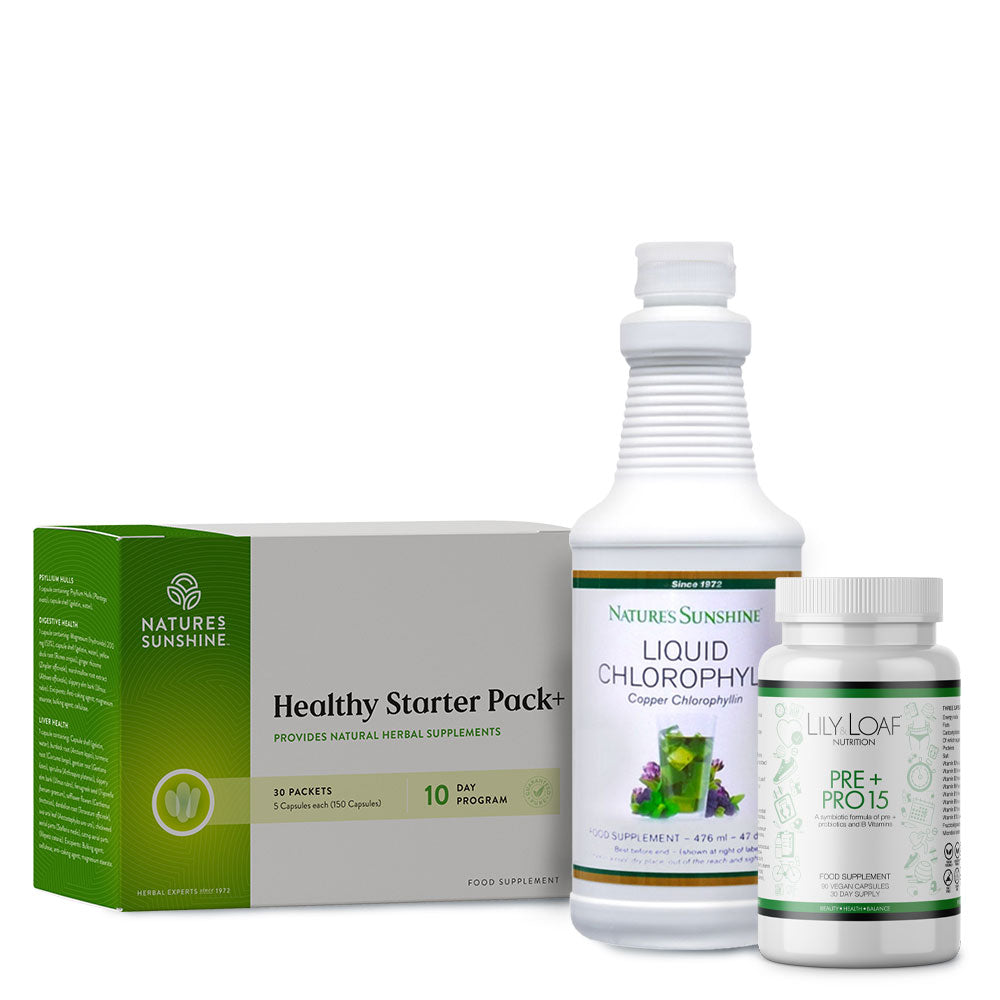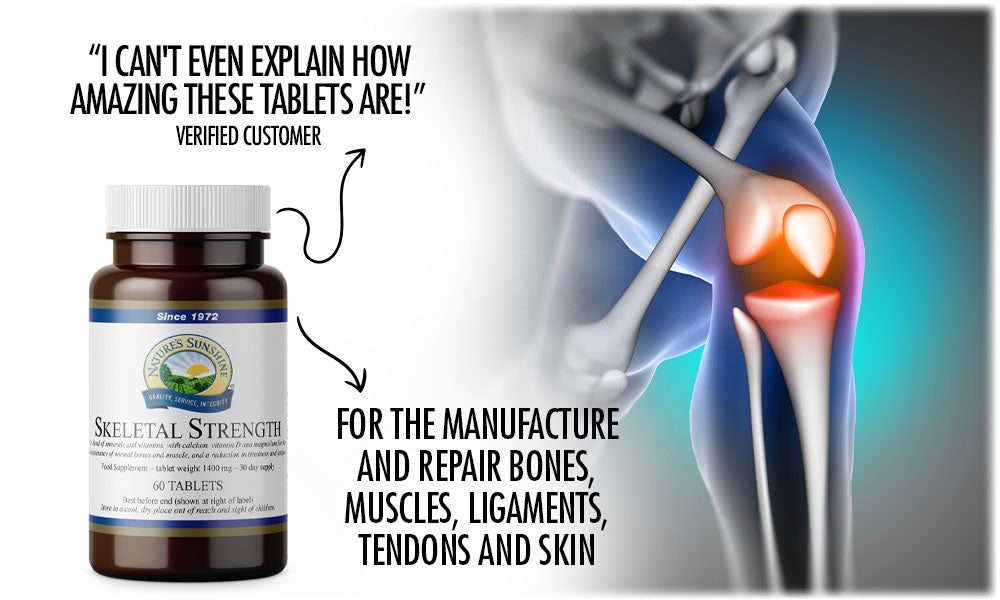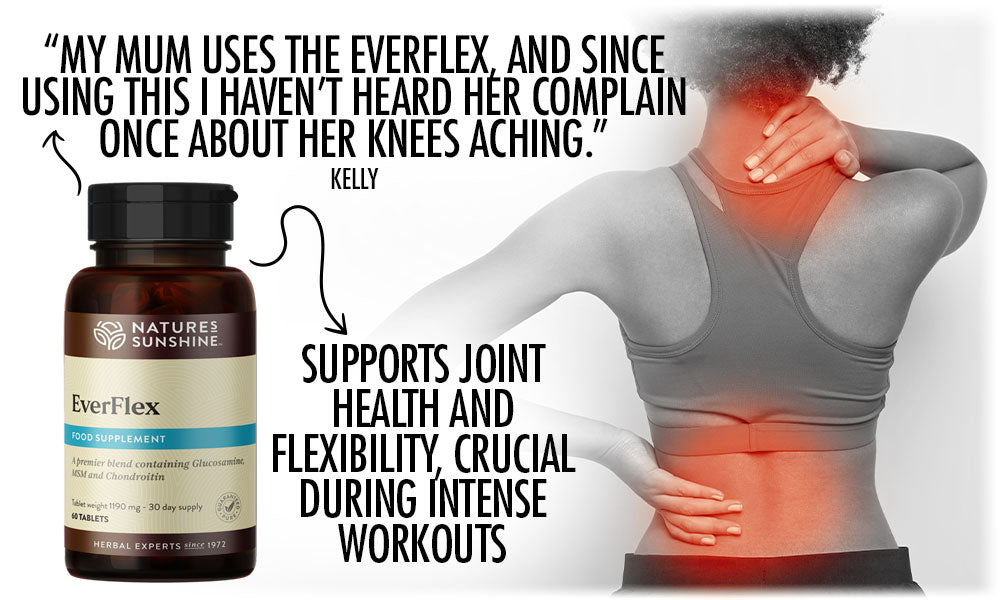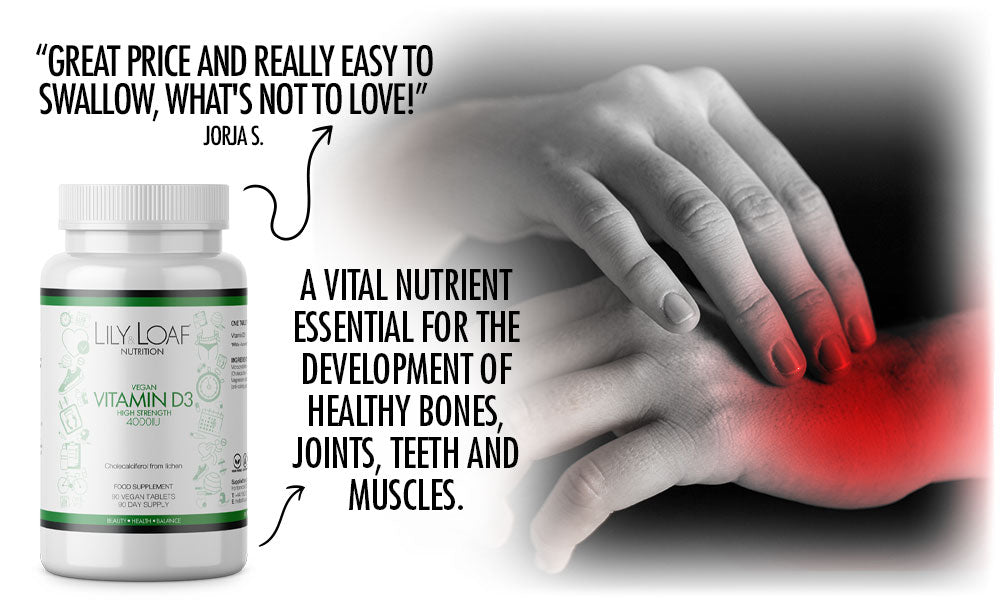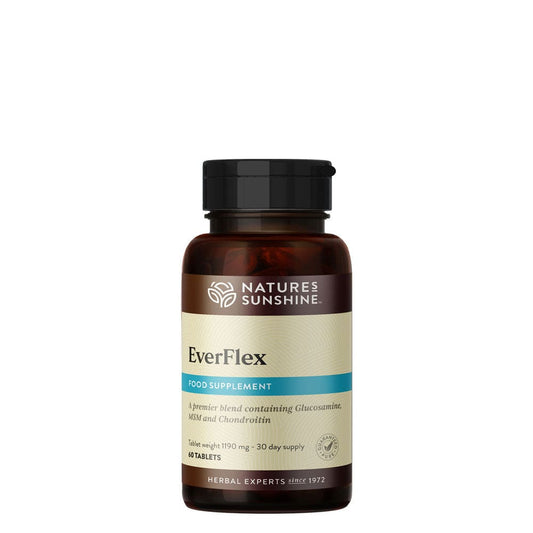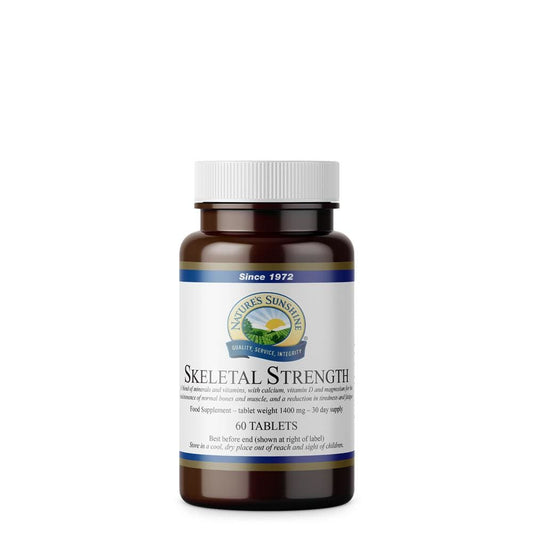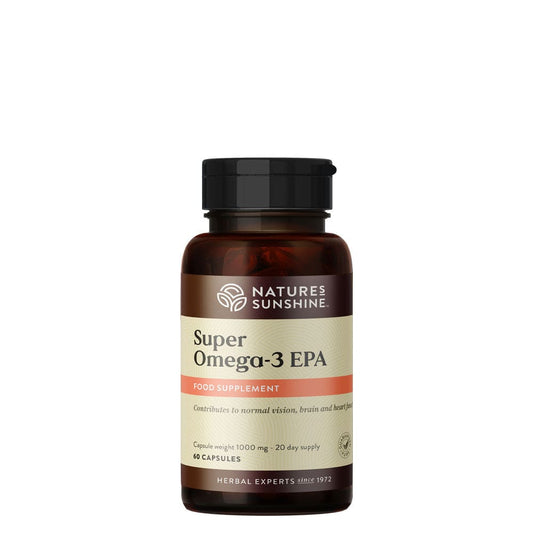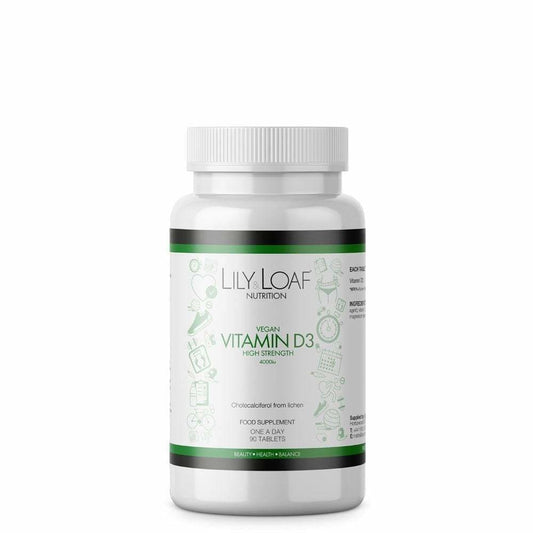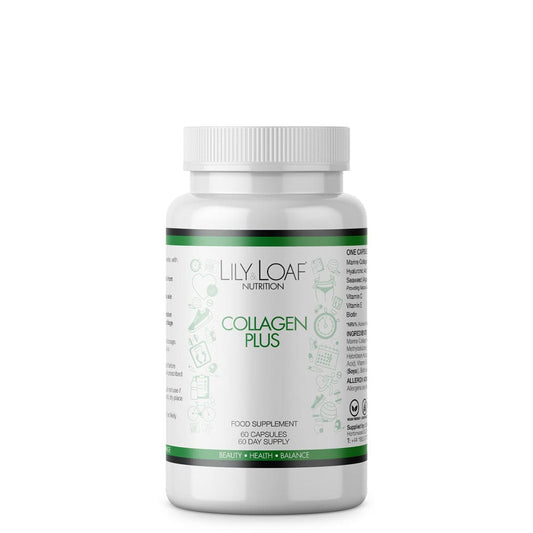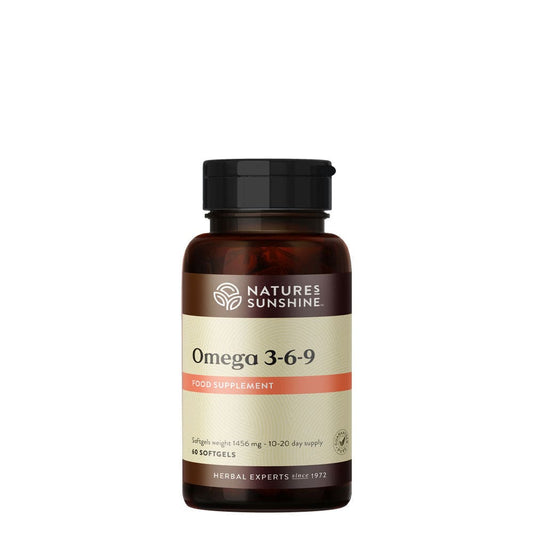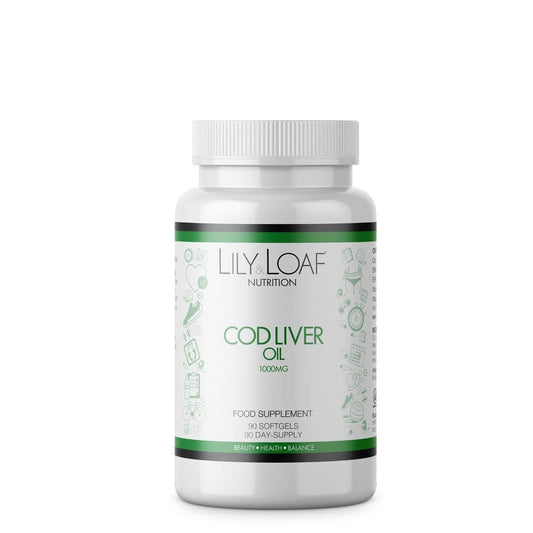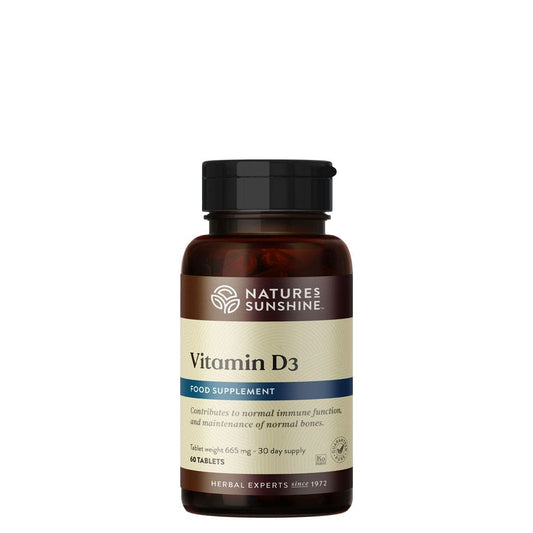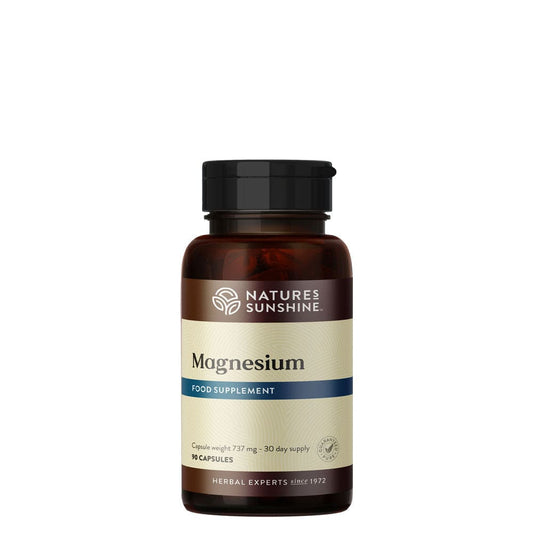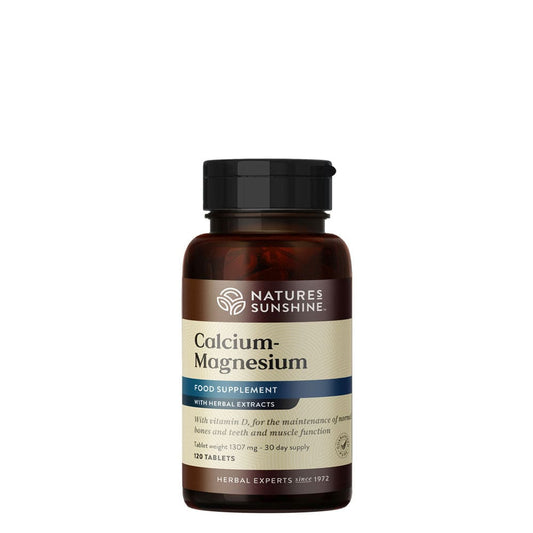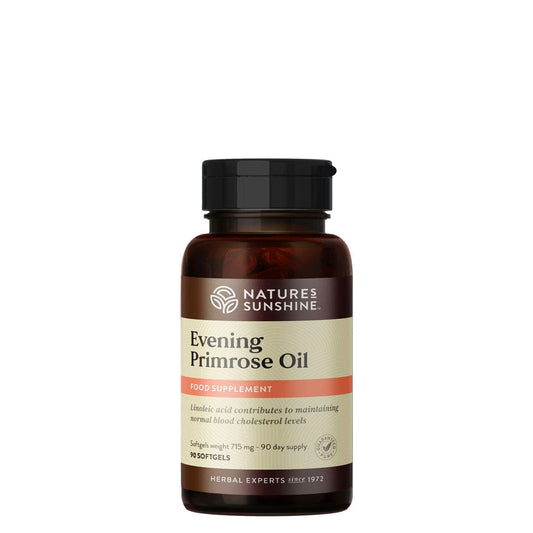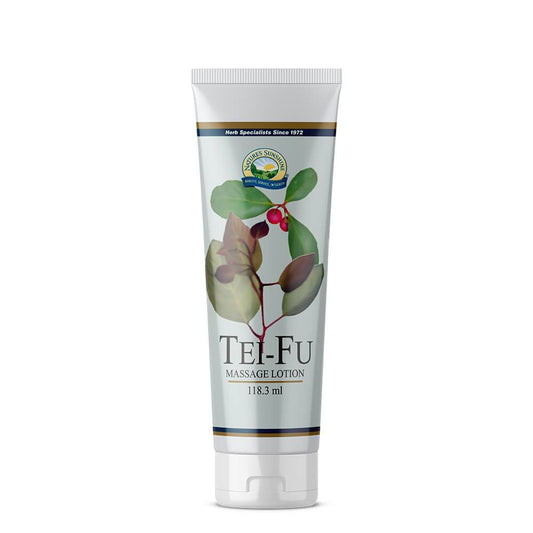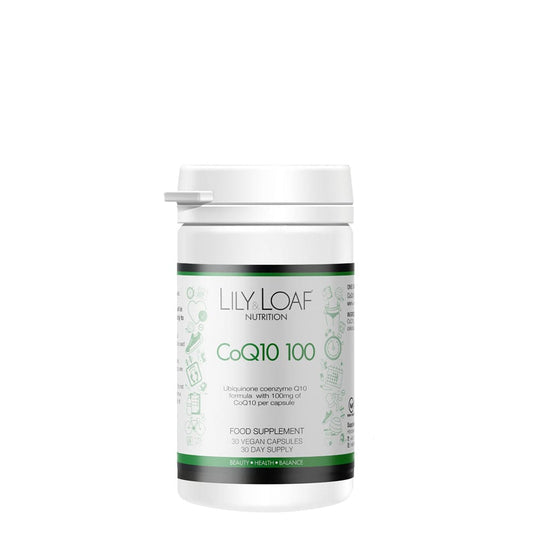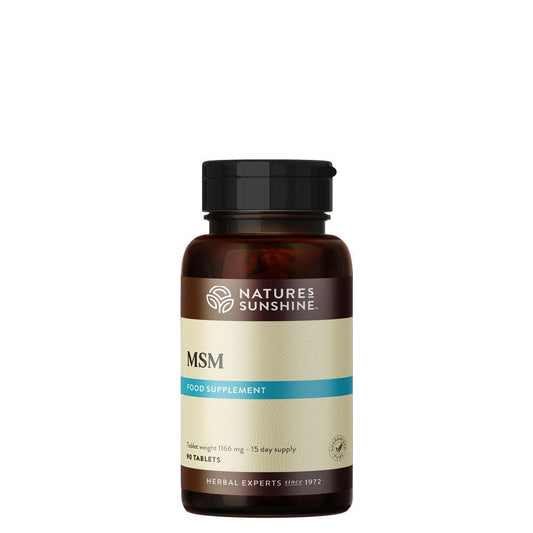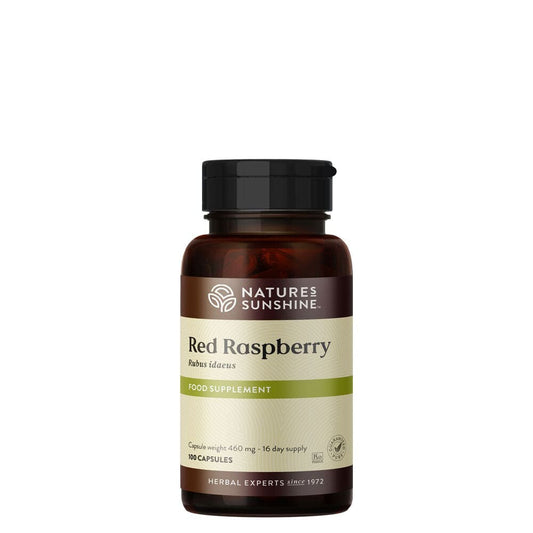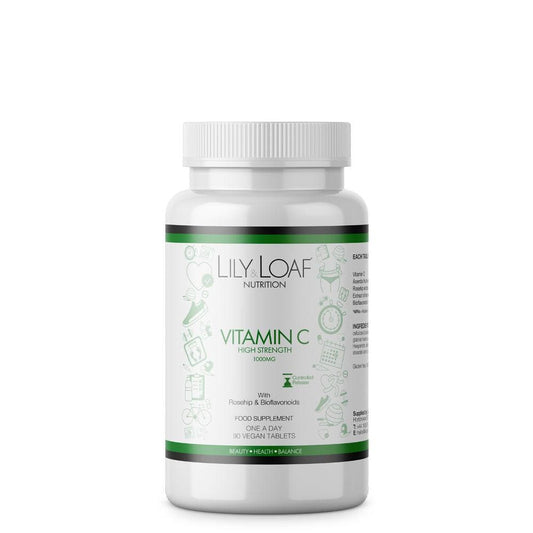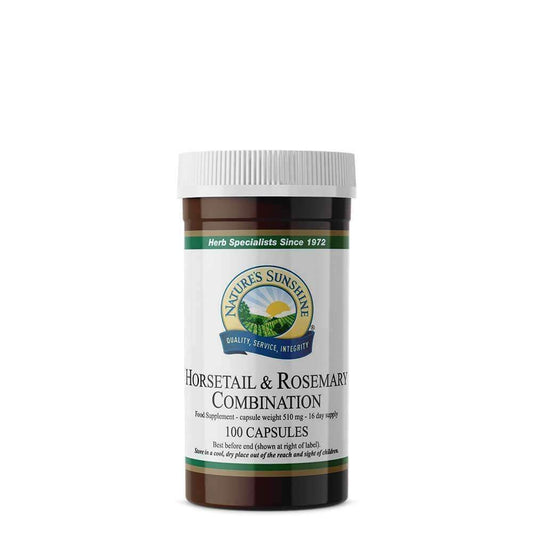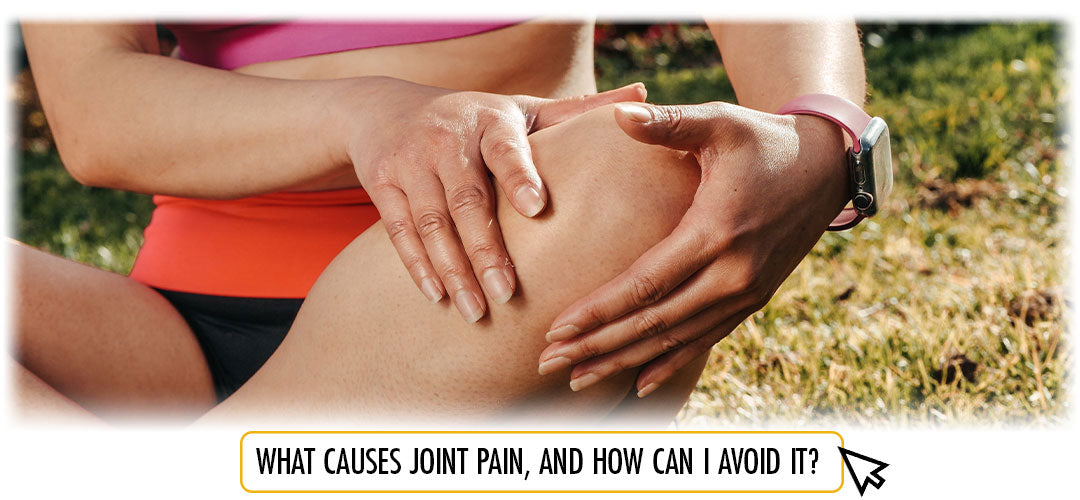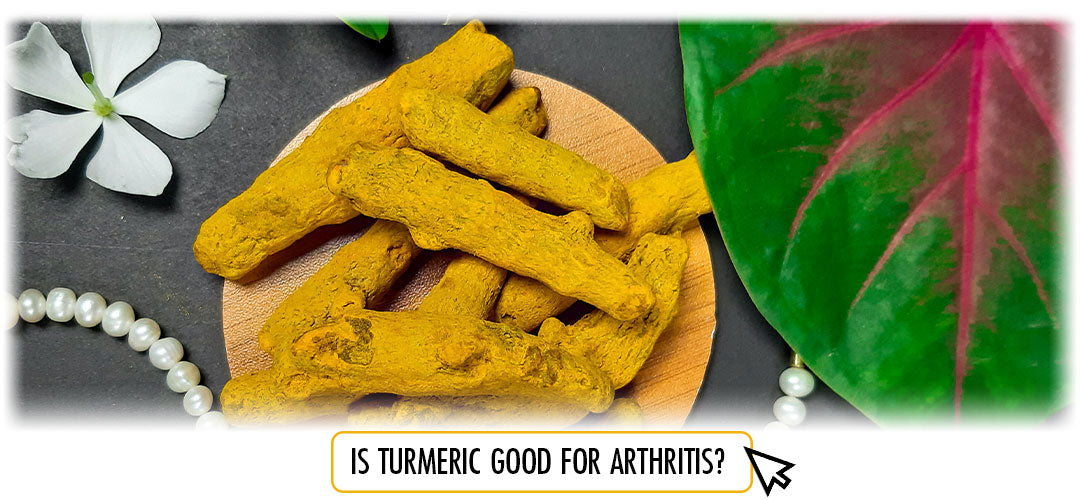Collection: Bone & Joint Health
Good bone and joint health are crucial if you want to enjoy a happy, healthy lifestyle. Without strong bones and joints, it can be hard to do some of the simple everyday physical activities that we all take for granted, such as walking, running and swimming.
-
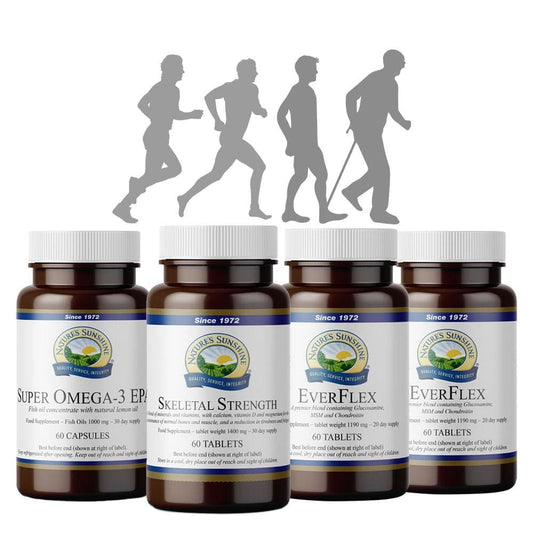 Money Saving Offer
Money Saving OfferJoint Health Support
Vendor:Nature's Sunshine30 to 40 Day Supply | 4 Full Size Products
Regular price Online Price: £49.95 GBPRegular priceUnit price / per£77.80 GBPSale price Online Price: £49.95 GBPMoney Saving Offer -
Skeletal Strength
Vendor:Nature's Sunshine30 Day Supply | 60 Vegan Tablets
Regular price Online Price: £11.95 GBPRegular priceUnit price / per -
Super Omega-3 EPA
Vendor:Nature's Sunshine20 Day Supply | 60 Softgel Capsules
Regular price Online Price: £24.95 GBPRegular priceUnit price / per -
Vitamin D3 High Strength
Vendor:Lily & Loaf90 Day Supply | Vegan
Regular price Online Price: £19.95 GBPRegular priceUnit price / per -
Collagen Plus
Vendor:Lily & Loaf60 Day Supply | 60 Capsules
Regular price Online Price: £18.45 GBPRegular priceUnit price / per -
Omega 3-6-9 - Flax Seed Oil
Vendor:Nature's Sunshine10-20 Day Supply | 60 Softgel Capsules
Regular price Online Price: £17.95 GBPRegular priceUnit price / per -
Cod Liver Oil 1000mg
Vendor:Lily & Loaf90 Day Supply | 90 Softgel Capsules
Regular price Online Price: £14.95 GBPRegular priceUnit price / per -
Vitamin D3
Vendor:Nature's Sunshine30 Day Supply | 60 Vegetarian Tablets
Regular price Online Price: £11.95 GBPRegular priceUnit price / per -
Calcium-Magnesium
Vendor:Nature's Sunshine30 Day Supply | 120 Tablets
Regular price Online Price: £16.95 GBPRegular priceUnit price / per -
Evening Primrose Oil
Vendor:Nature's Sunshine90 Day Supply | 90 Softgel Capsules
Regular price Online Price: £16.95 GBPRegular priceUnit price / per -
Tei Fu® Massage Lotion
Vendor:Nature's Sunshine118ml | Vegan
Regular price Online Price: £19.95 GBPRegular priceUnit price / per -
CoQ10 Ubiquinone 100mg
Vendor:Lily & Loaf30 Day Supply | 30 Vegan Capsules
Regular price Online Price: £12.95 GBPRegular priceUnit price / per -
Red Raspberry
Vendor:Nature's Sunshine16 Day Supply | 100 Capsules
Regular price Online Price: £13.95 GBPRegular priceUnit price / per -
Vitamin C High Strength 1000mg
Vendor:Lily & Loaf90 Day Supply | Vegan
Regular price Online Price: £12.95 GBPRegular priceUnit price / per -
Horsetail & Rosemary Combination
Vendor:Nature's Sunshine16 Day Supply | 100 Capsules
Regular price Online Price: £15.95 GBPRegular priceUnit price / per -
Hydrolysed Collagen + 4000mg High Strength
Vendor:Acti-Fit25 Day Supply | 500g
Regular price Online Price: £22.99 GBPRegular priceUnit price / per
TOP 10 FAQS
Bone & Joint Health
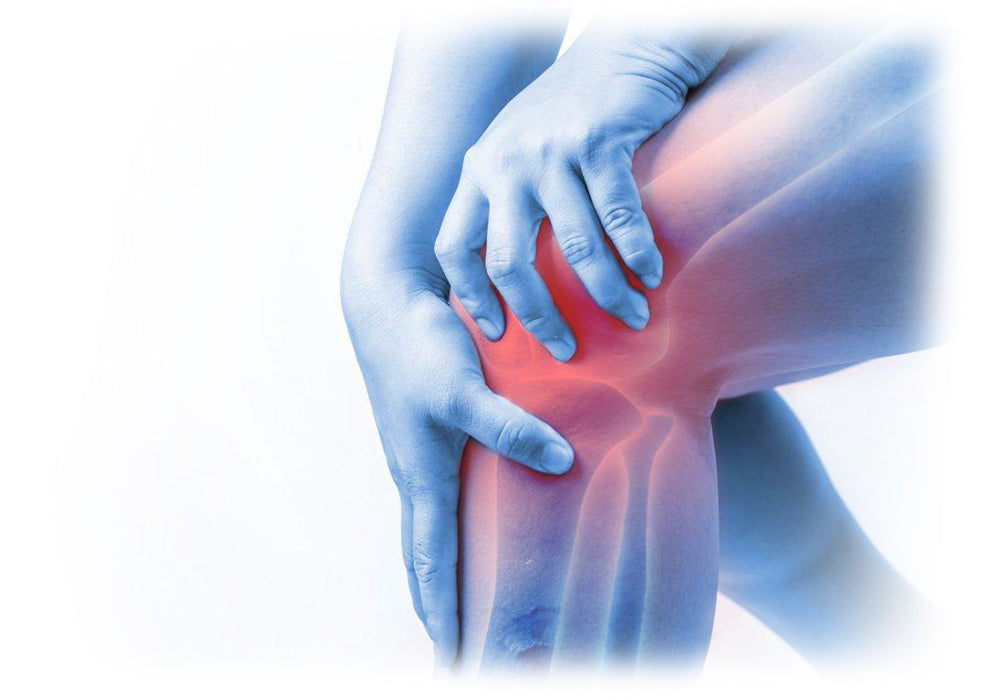
What are good sources of calcium for bone health?
Good sources of calcium include dairy products like milk, cheese, and yoghurt, green leafy vegetables such as kale and broccoli, and fortified foods like orange juice and cereals.
How can I naturally increase my bone density?
To naturally increase bone density, engage in regular weight-bearing exercises such as walking or jogging, consume a diet rich in calcium and vitamin D, and avoid smoking and excessive alcohol consumption.
What are the benefits of vitamin D for bones?
Vitamin D helps the body absorb calcium, which is crucial for building and maintaining strong bones. It is also important for bone repair and maintaining proper bone structure.
Are there natural supplements for joint health?
Yes, natural supplements like glucosamine, chondroitin, omega-3 fatty acids, and turmeric have been shown to support joint health and reduce inflammation.
Can exercise improve joint health?
Exercise can improve joint health by strengthening the muscles around the joints, maintaining bone density, improving flexibility, and reducing joint pain and stiffness.
How does obesity affect bone and joint health?
Obesity increases the risk of developing osteoarthritis due to the extra weight putting more pressure on the joints and can also lead to lower bone density and higher fracture risk.
What are the signs of poor bone health?
Signs of poor bone health can include a decrease in height over time, a stooped posture, bone fractures that occur more easily than expected, and bone pain and tenderness.
How can I protect my joint health as I age?
To protect joint health as you age, maintain a healthy weight, stay active, eat a balanced diet rich in nutrients, and manage any joint pain or stiffness with the help of a healthcare provider.
Can joint health supplements help with arthritis?
Some joint health supplements may provide relief from arthritis symptoms by contributing to the maintenance of cartilage and reducing inflammation.
Are there specific exercises for improving bone and joint health?
Yes, weight-bearing exercises like walking and resistance training can improve bone health, while range-of-motion and strengthening exercises can be beneficial for joint health. Always consult with a healthcare professional before starting a new exercise regimen, especially if you have existing bone or joint concerns.

As the scaffolding of our body, bones and joints perform essential roles, not just in supporting our structure but also in ensuring mobility and protection for our internal organs. However, like any other part of our body, they are prone to wear and tear, diseases, and the impact of our lifestyle choices. Understanding how to maintain bone and joint health is crucial, especially as we age.
• The Building Blocks of Bone Health
Bones are living tissues that continuously break down and rebuild. To facilitate this process, certain nutrients are paramount. Calcium serves as the primary building block, with Vitamin D playing a critical role in its absorption. Magnesium, Vitamin K, and phosphorus also contribute significantly to bone health.
Adults need about 1,000 milligrams of calcium per day, which increases to 1,200 milligrams for women over 50 and men over 70. Dairy products, leafy greens, and fortified foods are excellent calcium sources. Vitamin D can be synthesised by the body when exposed to sunlight, but it’s also found in fatty fish, eggs, and again, fortified foods.
• Exercise: The Unsung Hero of Bone Density
Physical activity isn’t just for weight management or cardiovascular health; it’s vital for bones too. Weight-bearing exercises, such as walking, running, and resistance training, force your body to work against gravity, stimulating bone tissue formation and increasing density. These activities also enhance balance and coordination, which can prevent falls and related fractures.
• Joint Health: The Articulation of Movement
Joints are the pivot points of our skeleton, allowing for flexibility and movement. To keep them functioning well, a diet rich in omega-3 fatty acids, antioxidants, and natural anti-inflammatory substances is beneficial. Foods like fish, nuts, seeds, and fruits, particularly those rich in Vitamin C, can help reduce inflammation and joint pain.
• Supplements: Do They Help?
The market is flooded with supplements promising bone and joint health. While some, like calcium and Vitamin D, have a well-established role, others like glucosamine and chondroitin are still debated. Before starting any supplement, it’s important to discuss with your healthcare provider, as the best approach is usually a combination of a balanced diet and an active lifestyle.
• Lifestyle and Its Impact on Your Framework
Lifestyle factors such as smoking and excessive alcohol consumption can have detrimental effects on bone mass and joint health. Smoking reduces blood flow to the bones, impairs calcium absorption, and slows the production of bone-forming cells. Alcohol can lead to bone loss and weaken muscles, impacting joints by changing the mechanics of movement, leading to an increased risk of injury.
• Obesity: A Weighty Issue for Bones and Joints
Excess body weight puts additional stress on bones and joints, particularly weight-bearing joints like the hips and knees. This can accelerate the wear and tear, leading to conditions like osteoarthritis. Maintaining a healthy weight through a balanced diet and regular exercise is key to relieving pressure on joints and bones.
• Recognising Bone and Joint Disorders
Awareness of conditions such as osteoporosis and arthritis is crucial. Osteoporosis makes bones brittle and more susceptible to fractures, often occurring with little to no warning. Arthritis, on the other hand, can cause pain and stiffness in the joints. Early detection and treatment are vital, so regular check-ups should not be neglected.
• Staying Ahead: Prevention and Management
Prevention is always better than cure. A diet rich in essential nutrients, regular physical activity, and avoidance of harmful substances are the cornerstones of bone and joint health. For those already experiencing issues, management might include medication, physical therapy, and sometimes surgery. However, lifestyle modifications can significantly improve quality of life even when conditions are present.
The interplay between bones and joints is intricate and reflects the complexity of our body’s design. Taking care of this system means we can enjoy a quality of life that comes with mobility and freedom from pain. Whether you’re in your prime youth or enjoying the golden years, the attention you pay to your bones and joints today will determine your body’s ability to support you in the future. Remember, when it comes to bone and joint health, the best approach is a proactive one.
-
Our Manufacturing Standards
All our products are manufactured to the highest ethical and sustainability standards, using premium natural ingredients that are free from many common allergens. We embrace a natural, holistic approach to health and wellbeing.
-
The Very Best Nature has to Offer
Our products are designed to ensure that your body gets the very best that nature has to offer, to help you fully reap the benefits of a happy, healthy lifestyle and help you look your best all day, every day.
